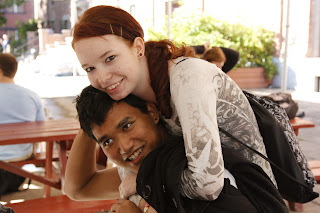“All advertising is good advertising.” Is a common statement made in today’s society of composed of the media and advertisements. However, there are a growing number of negative advertisements and references to companies. Not only do companies get exposed for crimes, confidential information leaks, and horrible accidents influence people in their purchasing but there are also a growing number of artists of create pieces that challenge and reveal the negativity of companies.
Sharad Haskar is one such artist who painted well known company brands – brands such as Nike, Coca-Cola, and IBM – in various Indian cities. After they were painted, he then had them photographed. Technically, the work of a street artist is not an advertisement for a company, but the symbol or icon of a brand is by itself an advertisement. The companies designed them to be recognizable to promote the brand as a standalone image.
Upon first glance of this particular photograph, it looks like a work that should be a painting. Whether or not that look is achieved from the way it was photographed or by the editing processes used. It is also rather funny, in a sad kind of way. There is an Indian child peeing on a wall with a big Nike ad right next to him. He doesn’t have any shoes on and does not care in the least bit what he is doing.
Despite Nike having a negative impact on the country, the image of a child peeing on a wall and not caring about what he is doing, combined with his stance is an image of empowerment. He does not care what he is doing. However, a person the same thing in North American could be charged with public urination and defacing private property. Whether intentional or not, Haskar gave the people of India a small way to feel empowered. He placed a symbol of a huge corporation that only makes poor conditions worse, in city space. With the difference in laws between North American society and Asian societies, the people of that country have the ability to do more to deface the symbol in India then would be able to in Canada.
Due to the historical presence of Nike in India it is evident to understand why the artist chose to place that particular symbol there. Nike has been caught using children as slaves in their factories in India, Pakistan, China and other undeveloped nations. Not just one time as well. Nike, along with many other corporations and companies have done the same and continue to, because the privileged nations of the world don’t want horrible working conditions for themselves. However, they don’t care if other people get stuck with the harsh conditions, so long as the prices of the products they want to buy are still cheap.
We are bombarded with advertisements and messages on a daily basis. The purpose of an ad is to convey a message in mere seconds. However, we don’t always take a deep look into what the ad is fully telling us. In this case, it is a photograph of a symbol of a company with an Indian child peeing on it. Haskar took this symbol and gave it to the people to do with what they like. The artists intentions are easy to see with his placement of the symbol. He gave the culture a small sense of empowerment that had been taken away from them and their children.





















